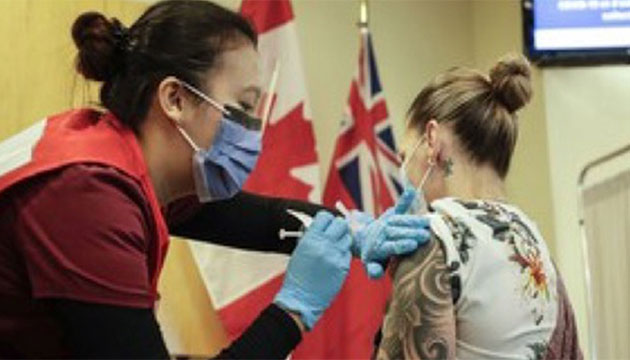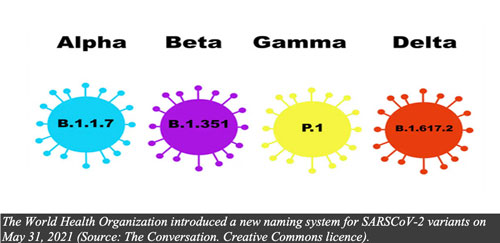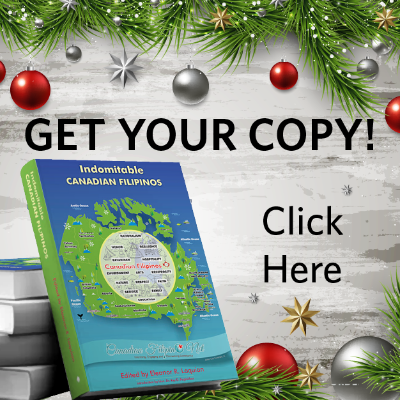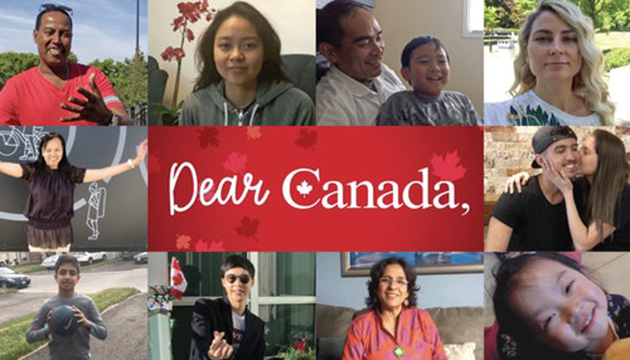(This is Part 40 of Dr. Pagtakhan’s column Medisina at Politika in Pilipino Express.)
[Editor’s Note: In February 2020, CFNet started publishing Dr. Rey Pagtakhan’s Commentary on COVID-19. Now on Part 40 of his running commentary, Dr. Pagtakhan – a retired lung specialist and former Member of Parliament – has kept the Filipino community and other CFNet readers continually informed about 1) the pandemic and its impact, 2) the scientific advances on drugs and vaccines, 3) the effectiveness of public health measures, including mass vaccination, 4) the danger of misinformation and disinformation, and 5) sound public health policy.]
“Joy to the world!” That was the opening statement in my column, Medisina at Politika, exactly a year ago today. I was reflecting on Canada’s mass immunization campaign against COVID-19 and its prospects at controlling the pandemic before the year 2021 ended [COVID-19 is a vaccine-preventable disease].
That was then, but before 2021 could close its calendar page, the world woke up on November 26 to the breaking news, “World Health Organization declares (COVID) B.1.1.529 a variant of concern. “WHO named it Omicron that same day. Two days later, Canada’s first two Omicron patients were identified in Ottawa. Then the report on December 22nd: “Canada sees record-breaking 14,456 new COVID-19 cases amid Omicron spread. “Barely a month after the initial alarming news, the ominous variant yet again stole the headlines: “COVID-19 cases in Canada top two million as hospitals brace for Omicron wave’s unknowns.”
Surpassing the two-million total case-count (2,038,832 cumulative cases) is a significant number of past and present COVID-sickened Canadians in a relatively less populated country (37,894,839). They constitute well over 5.40% of the nation’s population.
The Omicron’s onslaught at the dawn of 2022? This commentary looks at its impact and implications and offers some insights. First, what’s the latest on Omicron?
Ominous Omicron and the WHO update
Discovery and global distribution: South African scientists made the first discovery on November 24 when they tested specimen from samples collected as early as two weeks earlier. After confirming with more test samples, they promptly informed their government which then alerted the World Health Organization. On November 26, WHO gave it its Greek-alphabet name and its designation as a variant of concern (VOC). Other countries, upon review of their genome sequencing data on samples taken before the WHO’s alert, soon reported their similar findings, indicating that this VOC has already been circulating silently before. As of December 22nd, Omicron has been identified in 110 countries across all the WHO Regions and in every Canadian province.
 Nurse Venus Lucero on the first day of the Pfizer-BioNTech‘s COVID-19 vaccine being administered at a vaccination clinic at The Ottawa Civic Hospital at the launch on December 18, 2020 of Canada’s mass immunization campaign against COVID-19 (Photo by The Ottawa Hospital).
Nurse Venus Lucero on the first day of the Pfizer-BioNTech‘s COVID-19 vaccine being administered at a vaccination clinic at The Ottawa Civic Hospital at the launch on December 18, 2020 of Canada’s mass immunization campaign against COVID-19 (Photo by The Ottawa Hospital).
Mutations and variants: New variants of the COVID-19 virus continually develop as part of its life-cycle adaptation in the human host. While most are harmless, few render the virus harmful, that is, 1) more contagious, 2) more strong in inducing severe disease, 3) decreased effectiveness of available vaccines, or 4) less effectiveness of other public health measures. Genome sequencing of the virus enables scientists to identify any of these changes as potential threats to public health.
Omicron has over 50 divergent mutations, including 26-32 in the spike protein – the structure of the virus that, like a key on a lock, latches on the surface of the human cell and allows it to gain entry. It is also the part of the virus that currently available vaccines target for their efficacy. High transmissibility and evasion of immunity are two of Omicron’s disturbing behaviour.
Origin and evolution: Scientists have raised the question: Where and how did Omicron evolve? Lessons learned from such an inquiry could help medical science avoid more dangerous variants in the future. Three possible explanations have been offered, but none settled:
- The virus could have been circulating and evolving in a population setting that lacks surveillance and genome sequencing capabilities.
- The virus could have been residing for that long in a chronically infected COVID-19 patient.
- The virus might have evolved in a non-human species and recently spilled back into people.
There is apparent consensus it has evolved more likely in parallel and not from one of the earlier VOCs. Omicron is the fifth VOC; the four before are alpha, beta, gamma and delta [get vaccinated].

Symptoms: These include sore throat, hoarseness, nasal congestion, dry cough, and muscle aches manifesting in different areas but particularly in the lower back. Except for the lower back pain, the remainder could mimic symptoms of common upper respiratory infection so much so they can be easily disregarded. Some public health officers have suggested this may help explain the fast-moving and quiet spread of this highly contagious variant – a reminder that COVD-19 VOCs could present in many varied ways from mild and barely noticeable manifestation to severe.
Impact of Omicron and their implications
There is a growing consensus about the two harmful effects of Omicron alluded to above: high contagiousness and ability to evade immunity from vaccination and prior natural infection. It is thought to cause less severe disease than the Delta variant but no definitive ascertainment has been done pending further investigations. Below are some of the impacts of Omicron and their implications:
- Issuance anew of public health restrictions across the country implies renewal by governments of their budgetary commitments to help citizens and businesses affected by the measures;
- Resurgence of COVID cases at a rapid pacemeans1) increased hospitalization, 2) stressed health care system, and 3)potential shortage among health care staff; or, could result in 1) chaotic and confusing hospital settings where staff are called to serve in less familiar service areas – all these would place undue demands on health care institutions and services to the detriment of timely services to other patients, including relief from surgery backlogs;
- Resurgence of COVID cases in the community may also mean being extra-cautious when visiting elderly or vulnerable individuals and going into crowded, poorly ventilated businesses and entertainment facilities;
- Lack of adequate lab testing services could 1) jeopardize patient management, 2) hinder public health assessment of geographic areas requiring more attention, and 3) lead to difficulty in having a full picture of the pandemic surge and planning for a resurgence;
- Occurrence of many more breakthrough infections would necessitate appropriate responses from vaccine manufacturers and governments’ vaccination programs;
- Recurrence of COVID outbreaks in long-term care homes may require them to adopt and accelerate more stringent preventive measures, including 1) increased rapid testing, 2) restrictions on visitor numbers and 3) need for fourth doses and antiviral oral medications;
- COVID-19 outbreaks on college campus and schoolyard could mean shifting again to online instruction in colleges and schools and its consequence on other aspects of education and childhood development; and
- Emergence of Omicron and its onslaught reinforce 1) the importance of vaccination, including booster doses, in protecting against severe illness and death, 2) the vulnerability of those unvaccinated, 3) the need for continuing surveillance of the virus, including genetic sequencing to monitor for variants and to quickly detect their threats to public health, nationally and globally, and 4) the important role WHO plays in coordinating and monitoring the international community and in championing and achieving, not without difficulty, equitable distribution of vaccines globally.
Insights – What the future might hold
The headline, “WHO forecasts coronavirus pandemic will end in 2022,” in Politico Pro Newsletter’s issue of December 22, 2021 by Helen Collis more than simply caught my eyes. It made me pause long and reflect: Am I reading it correctly? As “the primary source for accurate, non-partisan news,” Politico Pro “provides forward-looking policy insights”…that keep readers “one step ahead of the rest.” Hence, my interest to share this insight.
Collis writes: “The global pandemic should come to an end next year, according to officials at the World Health Organization (WHO),” quoting the WHO Director-General Tedros Adhanom Ghebreyesus at the organization’s 2021 final briefing on the coronavirus: “2022 must be the end of the COVID-19 pandemic; we know the virus very well and we have all the tools [to fight it].”
WHO’s projections indicate sufficient vaccine supplies to immunize the global adult population and to give boosters to high-risk populations by the first quarter of 2022. The projections were premised on global vaccine equity and implementation of all the public health tools and on the principle that the pandemic cannot end unless the whole world is vaccinated. WHO’s technical lead at its Health Emergencies Program Dr. Maria Van Kerkhove shared her viewpoint: “My concern is whether we have the stamina to end it,” at once adding: “I believe we can.”
I add that G7 countries, Canada included, had warned a week earlier that Omicron is the “biggest threat to global public health.” They renewed their support for the COVAX initiative to guarantee access to the vaccine supply chain. Very encouraging, indeed.
Meanwhile, Omicron would likely be the dominant strain that would place a severe demand on Canada’s health care system. The case load will be driven by Omicron’s contagiousness and evasion of immunity while its handle on clinical severity will determine the magnitude of hospitalization, ICU admission, and deaths. How the country manages the appropriate mix of public health measures, the roll-out of booster doses and the availability of oral medicines would go a long way in helping facilitate the transition from the pandemic to the endemic phase of COVID-19.
To date, we are encouraged and can look forward to the availability of more treatment modalities (dexamethasone, monoclonal antibodies, newer oral medicines) capable of outpatient use and within the capability of Medicare. We could also be equally encouraged we would find solidarity as a society respecting adherence to public health measures as a common good. Within the spirit of solidarity, we should always be conscious of the populations at most risk – low-wage frontline workers, residents in crowded environments, and groups with little access to the health care system – and ensure we reach out to them.
Omicron’s arrival should remind us that the COVID virus is always producing new variants and a few of them could be harmful to life and living. Vaccination breaks the link between infection and severe disease or death. We have a duty to care for each other.
 Snowman reminds all to wear a well-fitting medical masks in view of the Omicron onslaught (Pixabay.com)
Snowman reminds all to wear a well-fitting medical masks in view of the Omicron onslaught (Pixabay.com)














